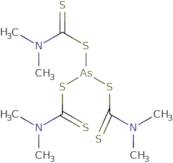Asomate
CAS: 3586-60-5
Ref. 3D-DAA58660
| 1g | Discontinued | ||
| 50mg | Discontinued | ||
| 100mg | Discontinued | ||
| 250mg | Discontinued | ||
| 500mg | Discontinued |
Product Information
- 2,4-dithia-6-aza-3-arsaheptan-1-amine, 3-[[(dimethylamino)thioxomethyl]thio]-N,N,6-trimethyl-1,5-dithioxo-
- Carbamic acid, dimethyldithio-, tris(anhydrosulfide) with (HS)<sub>3</sub>As
- Carbamic acid, dimethyldithio-, tris(anhydrosulfide) with thioarsenious acid
- Carbamic acid, dimethyldithio-, tris(anhydrosulfide) with thioarsenious acid (H<sub>3</sub>AsS<sub>3</sub>)
- Carbamodithioic acid, N,N-dimethyl-, anhydrosulfide with arsenotrithious acid (3:1)
- Carbamodithioic acid, dimethyl-, tris(anhydrosulfide) with arsenotrithious acid
- Thioarsenious acid (H<sub>3</sub>AsS<sub>3</sub>), tris(anhydrosulfide) with dimethyldithiocarbamic acid
- Tris(dimethyldithiocarbamato)arsenic
- Tris(dimethyldithiocarbamoyl)arsine
- Carbamic acid, dimethyldithio-, tris(anhydrosulfide) with (HS)3As
- See more synonyms
- Carbamic acid, dimethyldithio-, tris(anhydrosulfide) with thioarsenious acid (H3AsS3)
Trifluoroacetic acid (TFA) is an inorganic chemical that has been used as a metabolic control agent in diabetic patients. It is metabolized by the liver to trifluoroacetyl-CoA, which inhibits the synthesis of glucose and other metabolites. TFA also inhibits growth factor receptors on cells, leading to cell death. It has minimal toxicity and is not known to cause cancer or birth defects. Trifluoroacetic acid can be used in combination with picolinic acid and oxadiazole for the treatment of various diseases such as diabetes mellitus, cancer, and AIDS. The effective dose ranges from 50-100mg/kg body weight/day.





